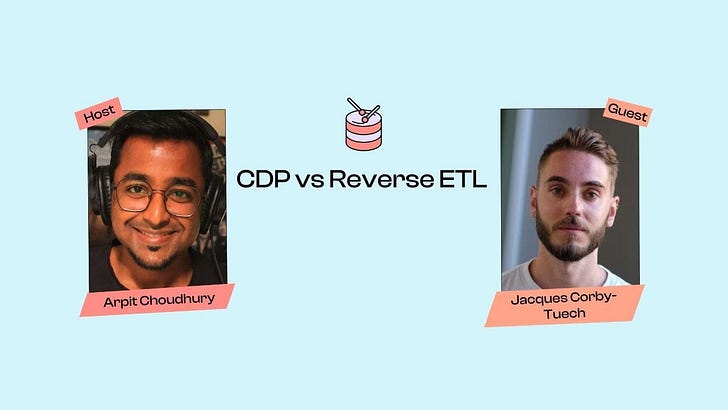Jacques Corby-Tuech, a revenue ops practitioner and a keen observer of the data technology landscape, uses both a CDP and a Reverse ETL tool.
In this episode, he answers some fundamental questions about the two technologies and explains how they solve very different problems.
He also explains where a Reverse ETL tool shines, and why positioning one as a CDP replacement is "frustrating marketing that's only causing confusion in the CDP market."
If you're looking to adopt a CDP or a Reverse ETL tool, Jacque's answers will certainly bring much-needed clarity and ease the evaluation process for you.
And if you’re not, well, you’ll hopefully derive some hard-to-find insights!
Let’s dive right in:
Q. Tell us a bit about your work. What makes you so passionate about data technologies?
I work as head of revenue operations at CyberSmart, a cybersecurity startup.
My role is to look at data process and technology for the marketing, sales, and customer experience teams — I need to find technology to enable all these teams to do the work that they need to do.
It's really important to me that I find technology and I find ways of helping those teams achieve the results they want in as efficient and scalable way as possible — so that's my angle on technology.
I'm not interested in technology for technology's sake, I'm interested in technology for the outcome that it provides me.
You don't shy away from voicing your opinions!
Q. What’s the deal with Reverse ETL tools sometimes being labeled as CDPs?
It's frustrating marketing to me, really.
I've got a background in marketing and I can understand why they're doing it, but all it's doing is causing confusion in CDP market. You know, it's frustrating!
They've got a great product that has so many merits that I think causing that frustration in the market doesn't necessarily do them any favors.
Reverse ETL, in my view, is one of the many components of a ready-made CDP.
Q. What are your thoughts here?
I think that's exactly what it is.
Reverse ETL is one of the small — probably one of the smallest parts — of what a CDP is capable of doing.
I think CDPs obviously can do significantly more and Reverse ETL can do other things well, which are perhaps more interesting.
And I believe CDPs aren't going anywhere anytime soon.
Q. Even if lots of organizations adopt Reverse ETL tools and data warehouses, will these tools eventually replace a ready-made CDP?
I don't think that moment is ever going to happen.
The barrier to entry for many businesses to get a data warehouse is very significant.
I think most businesses or a lot of businesses will still be using a CRM as their warehouse, right?
So I don't think it's necessarily reasonable that everyone will be needing or wanting Reverse ETL, much in the same way that most businesses won't necessarily need or want a CDP. They'll probably want a CRM or a CDP or some sort of Reverse ETL, but not necessarily all of them. Or they may want a combination of them depending on what they're trying to do.
Q. Do you think there's room for a CDP and a Reverse ETL to co-exist?
Absolutely! That's something that I'm actually exploring right now.
We use a CDP and that's not going anywhere, but we are looking at Reverse ETL to replace an iPaaS product.
And actually, it's performing incredibly in that area — I've really enjoyed working in it and testing it, and really the comparison against iPaaS is night and day. It's a fantastic product!
Let's talk about iPaaS.
Q. Do you think Reverse ETL can replace iPaaS at some point?
Reverse ETL is doing one thing really well — getting the data from the warehouse to the destination.
One thing that iPaaS does exceptionally well is doing it the other way, right?
So your CRM, your marketing platform, whatever might end up then being the source of data, sending data somewhere else. So I think that Reverse ETL captures one component particularly, but not necessarily everything else.
And there's a lot of maturity in iPaaS that's built up in terms of data security, integration, all of that kind of stuff that is actually very important and meaningful in this market.
And let's talk about CDP implementation.
Q. What do companies really need to implement a CDP successfully and typically how long does it take?
It really depends on the CDP and what the organization is trying to get out of it. If I think to my kind of my experience with CDPs, I've primarily used Segment and where Segment really shines is in their instrumentation libraries.
And so my view is — you need engineers to help you implement that instrumentation, which, depending on the complexity of your product, could take a few days or a lot longer.
From an operational perspective though, CDPs can be really quick to set up because all you need to do is kind of connect your CRM data or connect your email platform data and suddenly you've got a data flow going into your CDP.
It really depends what you're trying to do — you can get a very quick, easy implementation and then build upon it through engineering resource.
100% agree with you on that.
Q. And what do companies need to succeed with a Reverse ETL tool?
So I've been testing out Hightouch to replace an iPaaS platform and it's been really nice and easy.
So long as I can connect to my warehouse — I spoke to my CTO and he gave me connection users to test it out — I can query the data using SQL or some other means, and then actually building out that integration is just really nice and easy.
So I think it's a great product in that respect!
🤔 Have questions for Jacques?
Q. Should non-data teams or GTM teams care whether data is made available to them via a CDP or Reverse ETL?
Absolutely not. A GTM team should only really care about what the tool is enabling them to do, not how they're getting data.
There are situations where that may change though. For example, if they want a real-time data stream, there are things that they're going to have to consider to get that.
In that respect, a CDP is better to provide that real-time data stream than a Reverse ETL tool.
It really depends on what outcome they're after, and what trade offs they're able to, and willing to make in terms of costs and resources.
We've recently seen some CDPs become Reverse ETL-like.
Q. Do you think at some point popular CDP vendors will build or buy Reverse ETL capabilities?
Oh, yeah! I'm sure if you were to look inside those companies, they were 100% building those products already — it's a no brainer for them.
Q. And what are your thoughts on ETL/ELT vendors like Fivetran building or buying Reverse ETL capabilities?
It makes sense if you look at Airbyte — they've purchased a Reverse ETL company (Grouparoo), and they're looking to do the full thing.
It makes sense for anyone in this market to be looking to expand, not just uni-directionally but bi-directionally. Again, it just seems like a bit of a no-brainer. It seems like if you can do all of your integration in a single tool, that's what you should be looking to do.
I wasn't gonna ask you this question, but now I'm gonna ask you anyway.
Q. Do you think companies would want to eventually just pay for one data integration tool? Or would they be happy to pay separately for ETL, Reverse ETL, CDP, iPaaS, etc?
I'm in two minds about this 'cause there's that constant cycle of bundling versus unbundling, which is really interesting to follow.
But there is a significant amount of value in having a single tool that does these things. The trade-off, of course, is that actually that single tool may not be as good as dedicated point solutions. So it's just balancing those trade-offs versus what your actual requirements are.
I think there's space for both to exist.
With the money that was sloshing around in the data space at the tail end of last year, start of this year, these companies are 100% gonna be investing in purchasing companies that broaden them into more of a bundled suite or they'll be looking to be acquired by the big players to create more bundled solutions.
So there's room for both, but it's gonna be interesting to see what happens in the market as consolidation probably happens.
Q. With the rise of warehouse-native apps, should Reverse ETL vendors should try to go beyond moving data and diversify their offerings?
Can they somehow even enable traditional SaaS companies to become warehouse-native?
That's a really interesting angle. You know what, I'm not 100% sure where they can go to be honest.
The reality is that not every tool in the future is gonna be built to integrate directly with the warehouse.
Your Salesforce Marketing Clouds, your Marketos, these tools are very unlikely to be changing their entire infrastructure in the near future, right?
There is 100% a market that is going to remain on the actual app-hosted platforms for a very long time — whether or not that market ends up shrinking or growing, I'm not sure. The market right now for warehouse-native tools is minuscule, I'd be surprised if it was even 1% of the total market.
So there are definitely things that will happen, but I can't get out a crystal ball and see what that's gonna be in 10-plus years — if we'll see any kind of significant movement there.
Q. Last question — what's your advice for companies that are contemplating whether to go with a ready-made CDP or a Reverse ETL?
Don't look at technology, look at your use case.
Look at what you're trying to achieve, and then score the technology against that. Focus on outcomes.
The most important thing is to just focus on the outcome that you're trying to achieve, don't focus on technology.
I’d also add that think about the needs of your teams and give them the tools they're comfortable using.
Q. Because technology is no good if nobody uses it, right?
Yeah!
You can also tune in on Spotify or Apple Podcasts.
Prefer watching the interview?
🧠 If Jacques’ thoughts resonate, you’ll definitely enjoy his article on marketing and the modern data stack.













Share this post